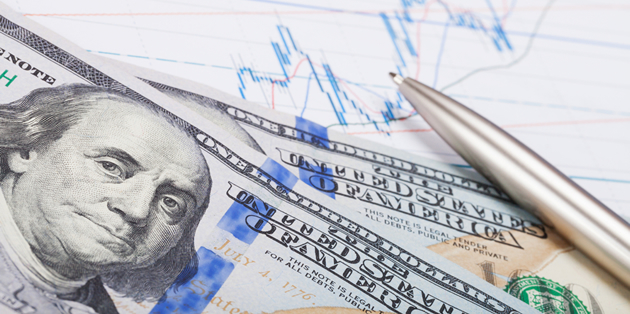- Euro US Dollar Exchange Attempts to Recoup Wednesday’s losses – Lack of strong European ecostats halt Euro rebound.
- European Central Bank Policy Meeting Minutes Released – ECB’s deadly bearish tone bodes poorly for EU economic outlook.
- First Round of US Job Data Failed to Impress Yesterday – Printing just above forecast, Investors focus on today’s crucial non-farm payrolls (NFP) release.
- Euro US Dollar Pairing Forecast to slide on Favourable NFP employment data.
The Euro US Dollar exchange rate gradually decreased yesterday as weak German industrial output saw the common currency tank across the board.
Whether or not the EUR USD currency pair is able to advance before the weekend largely depends on today’s key US release, the Non Farm Payrolls report. If the US jobs report disappoints, the Euro could advance on its US rival. The report from May was less-than-impressive, showing a far lower than forecast number of jobs added to payrolls.
After a previous rally, European stocks began to slide ever-so-slightly thanks to concerns over the German industrial output report printing poorly after being forecast for a marked rise. The report shows figures from the May period and, as such, does not include the post-Brexit figures, which may be notably more severe.
After the US Federal reserve made it clear that a near-term rate hike just was not within the bounds of reality, yesterday’s less impactful US jobs data has managed to print above expectations and stem any major US Dollar losses.
Towards the end of yesterday’s session, the Euro US Dollar exchange rate traded at just under the 1.11 mark and looks to be trending narrowly.
Euro (EUR) Fails to Find Support as Italian Bank Crisis Continues and ECB Concerns Increase
Weak German industrial data signalled the start of the Euro’s decline over yesterday’s session as the figures failed to print at forecast, instead showing production declining significantly.
The European Central Bank policy meeting minutes were released yesterday and, at a glance, reinforced Brexit-based fears for a negative outlook for the European economy. An excerpt from the minutes stated:
‘there could be significant, although difficult to anticipate, negative spillovers to the Euro area via a number of channels, including trade and the financial markets’
While notably vague, the quote does serve to highlight the shared believe that the Brexit will continue to inflict damage on the Eurozone and global economy in general.
The recent rise in mainland Euroscepticism has been observed to reverse in some areas as nations strive to avoid the current circumstances the UK finds itself in.
The Italian bank crisis continues to loom over the Euro’s value, ready to crash down upon it at any moment and as a result investors remain wary of the common currency while the situation plays out. Italian Prime Minister Matteo Renzi continues to eye up a €40 billion taxpayer funded bailout for the bank which, relatively speaking, is a rather small number to keep the sector afloat. Problems however stem from the recent new guidelines put forth in January. According to The Telegraph:
‘Brussels’ tough new Bank Recovery and Resolution Directive (BRRD) will require creditors to incur losses of at least 8pc of their total liabilities before receiving official sector aid. Britain will not be subject to the rules.’
US Dollar Lacks Support as Investors Await Non-Farm Payrolls Data Release
Historically July has always been a weak month for the US Dollar, the past four out of five years posting a Euro US Dollar exchange rate decline.
Slower employment growth and the looming referendum kept the US Federal Reserve from hiking rates in June and most notably, notorious hawk Jim Bullard conceded that reduced growth and a significantly low Fed funds rate were likely to remain in place for some time.
The reduced, almost non-existent, chances of a near-term rate hike have placed US Dollar support low after the initial post-Brexit surge of uncertainty kept safe-haven demand sky-high. Fed Chairwomen Janet Yellen also added fuel to the fire by mentioning in her twice-yearly address to the senate that she was decidedly less optimistic about the economic outlook and the prospect of rate hikes as she was last month.
Initially, the Fed announced that up to six hikes could be possible throughout 2016, following its decision to raise rates in December for the first time in over nine years. Now we may not even see one.
However, the Federal Reserve may take cues from today’s non-farm payrolls data if the figures print favourably.
Yesterday’s first round of employment data had mild effect on the ‘Buck’, printing just above expectations.
Euro US Dollar Exchange Rate Forecast Hangs on Today’s Non-Farm Payrolls and Unemployment Releases
The all-important non-farm payrolls and unemployment rate reports are set for release later today. Both hold a significant amount of weight in regards to US Dollar movement, as exhibited by last month’s dismal print all-but-disintegrating any chance of a near-term Fed rate hike.
The only European ecostat of note due for release before the weekend is this morning’s German trade balance report, that will go live at 7:30am. The figure is forecast to drop by over €2 billion which is not fantastic news for the export-based German economy, however even a drop of that magnitude keeps the balance comfortable at over a €20 billion surplus.
Taking ecostats out of consideration, it will mostly be general European stability placing influence on the common currency as the union still struggles to come to terms with the UK’s recent vote to Brexit.
Ultimately, the US payrolls report is the data to look out for and is likely to elicit the most movement in the Euro US Dollar exchange rate.



